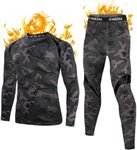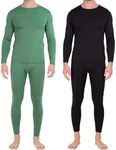Buying Guide for the Best Base Layer For Extreme Cold
Choosing the right base layer for extreme cold is crucial to ensure you stay warm, dry, and comfortable in harsh conditions. The base layer is the first layer of clothing you wear, and it plays a significant role in moisture management and insulation. When selecting a base layer, consider the material, weight, fit, and additional features that can enhance your comfort and performance in extreme cold environments.MaterialThe material of the base layer is important because it affects moisture-wicking, insulation, and comfort. Common materials include merino wool, synthetic fabrics, and silk. Merino wool is excellent for warmth, moisture-wicking, and odor resistance, making it ideal for prolonged use in cold conditions. Synthetic fabrics, such as polyester or nylon blends, are also good at wicking moisture and drying quickly, but they may not be as warm as wool. Silk is lightweight and comfortable but offers less insulation. Choose a material based on your activity level and personal preference for warmth and moisture management.
WeightThe weight of the base layer determines its thickness and warmth. Base layers come in lightweight, midweight, and heavyweight options. Lightweight base layers are best for high-intensity activities where you generate a lot of body heat, as they provide moisture-wicking without excessive warmth. Midweight base layers offer a balance of warmth and moisture management, suitable for moderate activity levels. Heavyweight base layers provide maximum insulation and are ideal for low-intensity activities or extremely cold conditions. Select the weight based on the intensity of your activity and the severity of the cold.
FitThe fit of the base layer is important for comfort and performance. A snug fit ensures that the fabric can effectively wick moisture away from your skin and provide insulation. However, it should not be so tight that it restricts movement or causes discomfort. A looser fit may be more comfortable for some, but it can reduce the effectiveness of moisture-wicking and insulation. Consider your personal comfort and the type of activities you will be doing when choosing the fit of your base layer.
Moisture-WickingMoisture-wicking is the ability of the fabric to draw sweat away from your skin and move it to the outer surface where it can evaporate. This is crucial in extreme cold because wet skin can lead to rapid heat loss and increase the risk of hypothermia. Look for base layers specifically designed to wick moisture effectively. Merino wool and synthetic fabrics are generally good at moisture-wicking. Choose a base layer with excellent moisture-wicking properties if you expect to sweat during your activities.
Odor ResistanceOdor resistance is a feature that helps keep your base layer smelling fresh, even after prolonged use. This is particularly important for multi-day trips or situations where you may not have the opportunity to wash your clothing frequently. Merino wool naturally resists odors due to its antimicrobial properties, while some synthetic fabrics are treated with antimicrobial agents to achieve similar results. If you plan to wear your base layer for extended periods without washing, consider choosing one with good odor resistance.
DurabilityDurability refers to how well the base layer can withstand wear and tear. In extreme cold conditions, you need a base layer that can handle the rigors of your activities without easily tearing or wearing out. Merino wool is generally durable, but it can be more prone to abrasion than synthetic fabrics. Synthetic base layers are often more resistant to wear and tear. Consider the durability of the material based on the type of activities you will be engaging in and how often you plan to use the base layer.
























